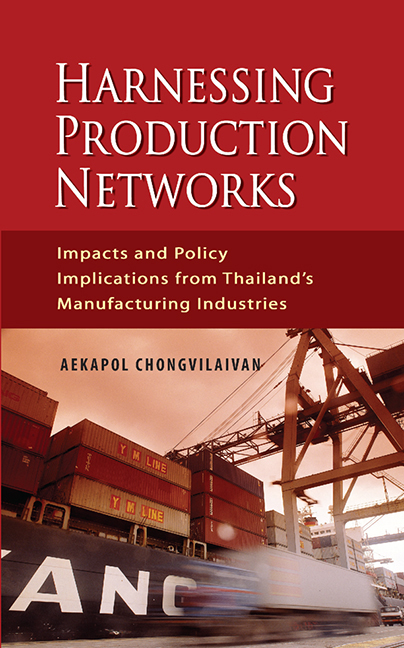 Harnessing Production Networks
Harnessing Production Networks Book contents
- Frontmatter
- Contents
- List of Tables and Figures
- Acknowledgements
- 1 Introduction
- 2 Characteristics of Firms in Thailand's Manufacturing Sector
- 3 Firm Productivity Effects
- 4 Labour Productivity Effects
- 5 Skills Upgrading: Winners or Losers?
- 6 Outsourcing Typology: Does It Matter?
- 7 Policy Implications
- Bibliography
- Index
- About the Author
7 - Policy Implications
Published online by Cambridge University Press: 21 October 2015
- Frontmatter
- Contents
- List of Tables and Figures
- Acknowledgements
- 1 Introduction
- 2 Characteristics of Firms in Thailand's Manufacturing Sector
- 3 Firm Productivity Effects
- 4 Labour Productivity Effects
- 5 Skills Upgrading: Winners or Losers?
- 6 Outsourcing Typology: Does It Matter?
- 7 Policy Implications
- Bibliography
- Index
- About the Author
Summary
Industrial Productivity Development
Since the last two decades, the formation of production fragmentation and networks in Southeast Asia has provided a wide array of business opportunities for local firms and Multinational Enterprises (MNEs) to leverage on ever-increasing productivity growth, especially in Malaysia, Singapore, Thailand and Vietnam. Based on this firm operating model, production stages are finely partitioned into many stages and carried out in different locations across regions and economies. As discussed in Chapter 3, there are at least two key mechanisms through which the prevalent use of production fragmentation accounts for a surge in firm productivity.
The first driver lies with vertical division and specialization of production factors, known as productivity gains from specialisation, and is attributable to technological advancement like computer and electronic revolutions in business management and operations. Thailand's machinery industry, for instance, participated in production and distribution networks by producing parts and components and supplying them to the growing mobile cluster industry. In this sense, outsourcing of parts and components allows the automobile and machinery industries to carry out what they are good at and ultimately enhance their productivity and competitiveness as a whole.
The other catalyst of productivity development is concerned with the improved access to intermediate inputs which are available at lower costs and/or better quality than what outsourcing firms had obtained by in-house production. This driving force of productivity growth emanates mainly from technology transfers and spillovers that help defray costs, expand varieties, and improve quality of intermediate inputs available to them. Furthermore, in comparison with in-house production, contracting out of production stages at arm's length offers much larger adjustability and resilience of production patterns and thus much more opportunities for firms to reap benefits from technology transfers or spillovers, especially the physical movements of technology and managerial know-how.
The latter productivity-enhancing mechanism is particularly vital to developing Southeast Asia as recent developments of production fragmentation and networks have presented new challenges of technology transfers and spillovers across industries and regions. Under the competitive business environment, arm's length transactions that entail industrial agglomerations and vertical division of production factors boost firms’ absorptive capacity of technology — a crucial element of technological spillover process. It would put pressure on local firms and MNEs to actively seek productive business partners and/or suppliers to secure their sources of intermediate parts and components at acceptable quality, specifications, prices and delivery timing.
- Type
- Chapter
- Information
- Harnessing Production NetworksImpacts and Policy Implications from Thailand's Manufacturing Industries, pp. 116 - 122Publisher: ISEAS–Yusof Ishak InstitutePrint publication year: 2011
